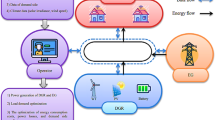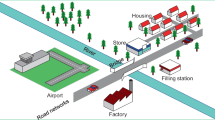Abstract
Recent statistical analysis of natural catastrophes reveals a rise in the number and intensity of incidents worldwide due to climate change. As a result, the urgency of utilizing cutting-edge technology to mitigate its damaging impacts is palpable. This paper presents a novel method aiming at increasing resilience which is based on (1) the installation of intelligently managed remote switches and (2) the optimization of the capacity of the Distributed Generations (DGs) considering the number of sensitive loads. The purpose of this study is to determine appropriate zoning by considering established limits and technical constraints imposed by a certain number of DGs. Each DG is considered to cover a portion of the loads, allowing for the restoration of additional high priority loads with the lowest available capacity in each region. The optimized system's primary function is input using the LP-metric technique with equal weight coefficients. The MILP optimization subject will identify the ideal Microgrid (MG) combinations for reclaiming the highest amount of load. The findings imply that the proposed scenarios are efficient in terms of the problem's stated objective function.










Similar content being viewed by others
References
President’s Council of Economic Advisers and the U.S. Department of Energy’s Office of Electricity and Energy Reliability (2013) Economic benefits of increasing electric grid resilience to weather outages. Executive Office of the President, U.S. Dept. Energy, Washington, DC, USA, Tech. Rep.
Gholami A, Aminifar F, Shahidehpour M (2016) Frontlines against the darkness. IEEE Electrif Mag
Li Z, Shahidehpour M, Aminifar F, Alabdulwahab A, Al-Turki Y (2017) Networked MGs for enhancing the power system resilience. Proc IEEE 105(7):1289–1310
Gholami A, Shekari T, Amirioun MH, Aminifar F, Amini MH, Sargolzaei A (2018) Toward a consensus on the definition and taxonomy of power system resilience. IEEE Access 6:32035–32053
Bie Z, Lin Y, Li G, Li F (2017) Battling the extreme: a study on the power system resilience. Proc IEEE 105(7):1253–1266
Bhusal N, Abdelmalak M, Kamruzzaman M, Benidris M (2020) Power system resilience: current practices, challenges, and future directions. IEEE Access 8:18064–18086
Wang Y, Chen C, Wang J, Baldick R (2015) Research on resilience of power systems under natural disasters—a review. IEEE Trans Power Syst 31(2):1604–1613
Dehkordi NM, Baghaee HR, Sadati N, Guerrero JM (2018) Distributed noise-resilient secondary voltage and frequency control for islanded MGs. IEEE Trans Smart Grid 10(4):3780–3790
Sedzro KS, Lamadrid AJ, Zuluaga LF (2017) Allocation of resources using a MG formation approach for resilient electric grids. IEEE Trans Power Syst 33(3):2633–2643
Gilani MA, Kazemi A, Ghasemi M (2020) Distribution system resilience enhancement by MG formation considering distributed energy resources. Energy 15(191):116442
Yadav M, Pal N, Saini DK (2020) MG control, storage, and communication strategies to enhance resiliency for survival of critical load. IEEE Access 8:169047–169069
Hussain A, Bui VH, Kim HM (2019) MGs as a resilience resource and strategies used by MGs for enhancing resilience. Appl energy 240:56–72
Che L, Khodayar M, Shahidehpour M (2013) Only connect: MGs for distribution system restoration. IEEE Power Energ Mag 12(1):70–81
Campbell RJ (2012) Weather-related power outages and electric system resiliency. Congressional research service, Washington, DC, USA, Tech. Rep. R42696
Chaouachi A, Kamel RM, Andoulsi R, Nagasaka K (2012) Multiobjective intelligent energy management for a MG. IEEE Trans Ind Electron 60(4):1688–1699
Wang MQ, Gooi HB (2011) Spinning reserve estimation in MGs. IEEE Trans Power Syst 26(3):1164–1174
Conti S, Rizzo SA (2013) Modelling of MG-renewable generators accounting for power-output correlation. IEEE Trans Power Deliv 28(4):2124–2133
Ahn SJ, Nam SR, Choi JH, Moon SI (2013) Power scheduling of distributed generators for economic and stable operation of a MG. IEEE Trans Smart Grid 4(1):398–405
Pham TT, Bésanger Y, Hadjsaid N (2009) New challenges in power system restoration with large scale of dispersed generation insertion. IEEE Trans Power Syst 24(1):398–406
Khushalani S, Solanki JM, Schulz NN (2007) Optimized restoration of unbalanced distribution systems. IEEE Trans Power Syst 22(2):624–630
Li J, Ma XY, Liu CC, Schneider KP (2014) Distribution system restoration with MGs using spanning tree search. IEEE Trans Power Syst 29(6):3021–3029
Chen C, Wang J, Qiu F, Zhao D (2015) Resilient distribution system by MGs formation after natural disasters. IEEE Trans Smart Grid 7(2):958–966
Baran ME, Wu FF (1989) Optimal capacitor placement on radial distribution systems. IEEE Trans Power Deliv 4(1):725–734
Yeh HG, Gayme DF, Low SH (2012) Adaptive VAR control for distribution circuits with photovoltaic generators. IEEE Trans Power Syst 27(3):1656–1663
Haghifam MR, Malik OP (2007) Genetic algorithm-based approach for fixed and switchable capacitors placement in distribution systems with uncertainty and time varying loads. IET Gener Transm Distrib 1(2):244–52
Panteli M, Mancarella P (2015) The grid: stronger, bigger, smarter? Presenting a conceptual framework of power system resilience. IEEE Power Energy Mag 13(3):58–66
Panteli M, Pickering C, Wilkinson S, Dawson R, Mancarella P (2016) Power system resilience to extreme weather: fragility modeling, probabilistic impact assessment, and adaptation measures. IEEE Trans Power Syst 32(5):3747–3757
Author information
Authors and Affiliations
Corresponding author
Additional information
Publisher's Note
Springer Nature remains neutral with regard to jurisdictional claims in published maps and institutional affiliations.
Rights and permissions
Springer Nature or its licensor (e.g. a society or other partner) holds exclusive rights to this article under a publishing agreement with the author(s) or other rightsholder(s); author self-archiving of the accepted manuscript version of this article is solely governed by the terms of such publishing agreement and applicable law.
About this article
Cite this article
Hosseinzadeh, A., Zakariazadeh, A. Enhancing the resilience of distribution systems through optimal restoration of sensitive loads based on hybrid network zoning. Electr Eng 105, 745–760 (2023). https://doi.org/10.1007/s00202-022-01695-1
Received:
Accepted:
Published:
Issue Date:
DOI: https://doi.org/10.1007/s00202-022-01695-1




